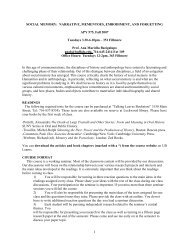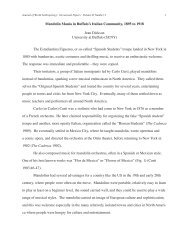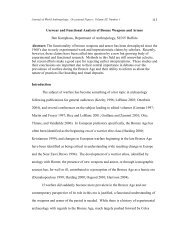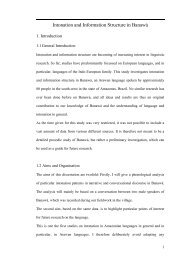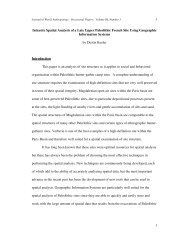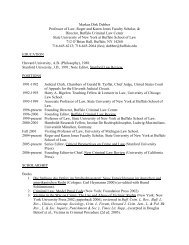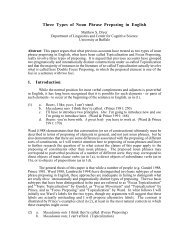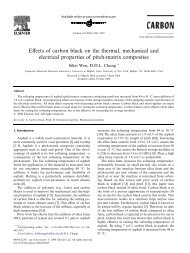Electrophysiological Evidence for Sentence Comprehension - Wings
Electrophysiological Evidence for Sentence Comprehension - Wings
Electrophysiological Evidence for Sentence Comprehension - Wings
You also want an ePaper? Increase the reach of your titles
YUMPU automatically turns print PDFs into web optimized ePapers that Google loves.
In the same paragraph Hagoort et al. make difference between syntactic preferences and<br />
syntactic violations claiming that the violations elicit more posterior while syntactic<br />
preferences elicit more frontal distribution. The P600 elicited in the ‘case’ experiment<br />
shows both frontal and parietal distribution at different latencies. The frontal distribution<br />
shows clear left hemisphere maximum while the second part shows central distribution.<br />
While case violation can be easily related to the posterior part of the P600, in this<br />
experiment there is no difference in preferences between the conditions. There<strong>for</strong>e, the<br />
two phases in the P600 component could be interpreted in terms of violation only:<br />
constituent error, i.e. argument structure error detection, macrorole violation, i.e. syntax-<br />
to-semantics mapping and integration and repair. In such interpretation constituent<br />
structure error detection can be related to LAN, macrorole violation with the left anterior<br />
portion of P600 while repair and integration processes can be related to the second phase<br />
of the P600 component. This is, in a way, in accordance with Bornkessel & Schlesewsky<br />
(in press) in which they report an ‘early positivity’ and ‘P345’ <strong>for</strong> macrorole violation in<br />
German, Dutch and English (<strong>for</strong> example, in the German verb final sentences with object<br />
in the Dative as in …dass der Dirigent den Sängerinnen aufällt. The verb requires the<br />
Undergoer macrorole <strong>for</strong> the noun in Nominative and the initial macrorole assignment<br />
based on the Nom.–Dat., i.e. marked word order – Actor - should be changed, thus the<br />
increased processing costs occur). The difference in latency between the German<br />
examples and the results in the present study can be attributed to the difference in the<br />
availability of the macrorole in<strong>for</strong>mation; while in the German example the noun in<br />
Dative precedes the verb, in the present study the noun in the Dative was the very last<br />
word in the sentence. In the other words, in the German examples macroroles are already<br />
93





